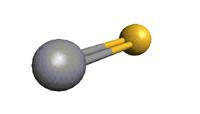|
Details of the global fit involving several isotopomers are
available in
(1) H. S. P. Müller, F. Schlöder, J. Stutzki, and G. Winnewisser,
2005, J. Mol. Struct. 742, 215.
The pure rotational lines were taken from
(2) M. Bogey, C. Demuynck, and J. L. Destombes,
1981, Chem. Phys. Lett., 81, 256; from
(3) M. Bogey, C. Demuynck, and J. L. Destombes,
1982, J. Mol. Spectrosc., 95, 35; from
(4) V. Ahrens and G. Winnewisser,
1999, Z. Naturforsch. 54a, 131;
(5) E. Kim and S. Yamamoto,
2003, J. Mol. Spectrosc., 219, 296;
and from
(6) C. A. Gottlieb, P. C. Myers, and P. Thaddeus
2003, Astrophys. J., 588, 655.
Infrared transitions v = 1 – 0 for several isotopomers
and v = 2 – 1 for the main isotopomer by
(7) J. B. Burkholder, E. R. Lovejoy, P. D. Hammer, and C. J. Howard 1987,
J. Mol. Spectrosc. 124, 450;
v = 1 – 0 to v = 9 – 8 of the
main isotopomer by
(8) R. S. Ram, P. F. Bernath, and S. P. Davies,
1995, J. Mol. Spectrosc. 173, 146;
and
v = 2 – 0 of the main isotopomer by
(9) R. J. Winkel, Jr., S. P. Davies, R. Pecyner, and J. W. Brault;
1984, Can. J. Phys. 62, 1414
were also used in the fit.
In general, lines deviating from their calculated position by
more than 2.5 times their uncertainties have been omitted from
the final fit. Transition frequencies with
uncertainties >= 100 kHz have not been merged.
In very cold and quiescent sources it may be possible
to resolve the 13C spin-rotation splitting.
Therefore, a separate
hyperfine calculation up to J = 5 is provided.
Note:The partition function given below
takes into account this splitting !
The dipole moments were assumed to be the same as for the main
isotopomer, see e044501.cat.
All vibrational states used in the fit have been considered
for the calculation of the partition function. Contributions
of the individual vibrations are given in parentheses.
|
